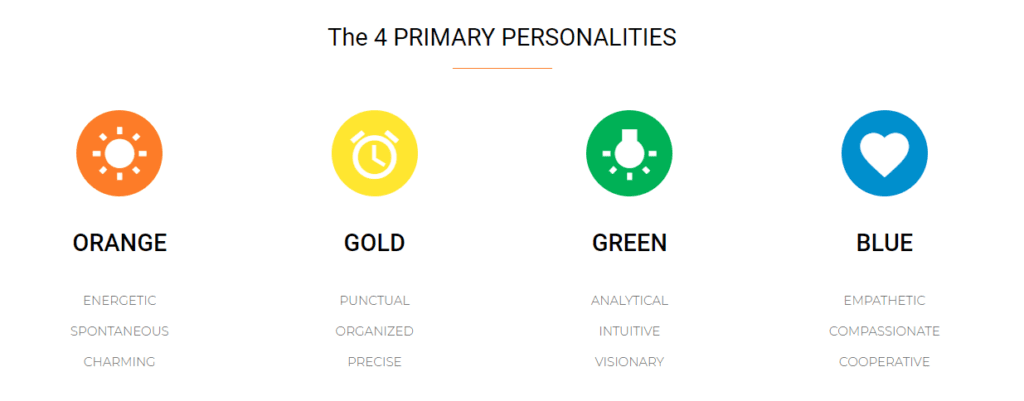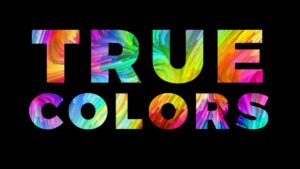What are the True Colors Personality Types?
Don Lowry developed the True Colors Four Personality Temperaments model in 1978 based on the Keirsey Temperament Sorter, which adapts the 16 Myers-Briggs Personality Types (MBTI) into Four Personality Temperaments.
However, Lowery, a student of David Kiersey, focused more on core motivation, intrinsic values, and communication styles among individuals in the workplace, family, school, and other social gatherings.
Each True Color, Gold, Blue, Green, and Orange, is associated with certain Personality Traits or behaviors and correlates with the four Keirsey MBTI Temperaments.

Lowery proposed that True Colors is a developmental process that you can observe throughout an individual’s life.
The first Color develops during the early phases of life, between six and twelve years of age. Between twelve and twenty, your second Color develops, supporting your first Color. Later, your third and fourth Colors emerge throughout your twenties, thirties, and forties.
Blues are Keisey Idealists
Blues motivate and inspire others to get the job done, usually peacefully. They can find peace when others are out of control.
Golds are Keisey Guardians
Golds are task-oriented and want to accomplish the job because that’s their goal. They like rules, policies, and procedures. They respond to duty and loyalty.
Greens are Keisey Rationalists
They see the big picture and are usually intellectual and philosophical. If you give the green an assignment and don’t tell them why, they probably won’t do it. They need to know why.
Oranges are Keisey Artisans
Oranges are risk-takers and are action-oriented. They are adventurous, impulsive, and competitive and tend to test their limits.
Oranges don’t like to sit around and decide how to deal with the problem. They want to go out and get it done.
Personality Temperaments, Traits, and Types
Personality Temperaments, Traits, and Types are used in psychology to discuss a person’s Personality, and although often used interchangeably, the differences are worth understanding.
Personality is a collection of Emotions, Perceptions, and Actions that interact with each other and regulate themselves, shaping a dynamic system that forms a person’s “Behavioral Patterns.”
Many factors affect a person’s Personality, such as education, socialization, and other pressures and aspects of life.
Personality Traits are observable characteristic patterns of Thoughts, Feelings, and Behaviors that are consistent and stable over time and across different situations throughout your life. Three criteria characterize Personality Traits: (1) consistency, (2) stability, and (3) individual differences.
For example, if you are talkative at home, you are also talkative at work. And if you were talkative as a child, you are still talkative as an adult.
Personality Temperaments are biological Traits that are partly inherited through your genes and partially determined by your brainstem. They don’t change throughout your life.
These “Natural Traits” are regarded as innate, inborn, and not learned. Your Personality Temperament is formed as an infant and never changes. It is also hard to modify, manipulate, or change because it is genetic. In some way or another, your inherited behavioral tendency will always be there.
A Personality Type identifies a specific collection of Traits, both learned and natural, comprising a broad, general classification. Personality Types involve qualitative differences between people, whereas Personality Traits are the quantitative differences between people.
The most crucial difference between Trait Theory and Type Theory is that Type Theory views people’s characteristics as discrete categories, while Trait Theory views these characteristics as a continuum.
For example, while a Type Theorist would claim that introverts and extraverts are two types of people, a Trait Theorist claims that extraversion is a gradient, and individuals can fall somewhere in the middle.
So, your Temperaments and acquired Traits form your Personality.
The Orange “Impulse-Oriented” Personality Type

Orange is often used to promote action, motivation, and excitement. It urges you to PAY ATTENTION – wake up and seize the moment, make quick decisions…take advantage of the immediate opportunity available right now!
Orange encourages a playful atmosphere of activity and movement.
Think of the flash of fire, shimmer of sparklers on the fourth of July, or the flame of a match – hot, dazzling, Orange energy.
The Orange Personality Traits
- Oranges act on a moment’s notice.
- They consider life a game and like to live here and now.
- They need fun, variety, stimulation, and excitement.
- Oranges value skill, resourcefulness, and courage.
- They are a natural trouble-shooter, a performer, a competitor.
- Oranges are witty, charming, and spontaneous.
- They are impulsive, generous, and impactful.
- Oranges are optimistic, eager, and bold.
Orange Personality Type cross-reference
- Keirsey Type – Artisans
- Temperament Type – Sanguine
- Animal Type – Golden Retriever
- DISC Type – Steadiness
- Socio-Communicative Type – Amiable
- Color Code – Yellow
- Personality Compass – South
- Occupational Type – Conventional
Orange MBTI Personality Types (xSxP) – Sensing and Perceiving
Learn more about the true orange color personality style.
The Gold “Structure-Oriented” Personality Type

Gold is a color with numerous metaphors associated with it. Think of the common phrase, “Good as Gold.” It represents value, stability, and strength.
The expression “Solid Gold work ethic” creates an image of someone responsible… on time, organized, and fulfilling their obligations with stellar dependability, efficiency, and thoroughness.
The classic expression “sets the Gold standard” is also suitable.
The Gold Personality Traits
- Golds are a natural preserver, parent, and helper.
- They value home, family, and tradition.
- Golds have a strong sense of what is right and wrong in life.
- They need to follow the rules and respect authority.
- They need to be helpful and belong.
- Golds are loyal, dependable, and prepared.
- They are faithful, stable, and organized.
- Golds are caring, concerned, and concrete.
- They are thorough, sensible, and punctual.
Gold Personality Type cross-reference
- Keirsey Type – Guardians
- Temperament Type – Melancholy
- Animal Type – Beaver
- DISC Type – Compliant
- Socio-Communicative Type – Analytical
- Color Code – White
- Personality Compass – East
- Occupational Type – Realistic
Gold MBTI Personality Types (xSxJ) – Sensing and Judging
Learn more about the Gold True color Personality Style.
The Green “Cognitive-Oriented” Personality Type

Green is an expression of logic – the system of existence and the abundance of this Color in nature.
Greens are concerned with the world’s challenges, such as preserving Mother Earth’s wisdom for the future.
Psychological research has shown the color Green to have a calming effect.
In addition, many Greens demonstrate a composed demeanor, using mind over emotion to orchestrate and solve the mysteries of life.
The Green Personality Traits
- Greens seek Knowledge and Understanding.
- They are Abstract, Hypothetical, and Investigative.
- They are Analytical, Logical, and Inventive Problem Solvers.
- Greens are natural non-conformists, Visionaries, and Perfectionists.
- They live life by High Standards.
- Greens value Intelligence, Insight, Fairness, and Justice.
- They are Calm, Cool, and Collected.
Green Personality Type cross-reference
- Keirsey Type – Rationals
- Temperament Type – Choleric
- Animal Type – Lion
- DISC Type – Dominant
- Socio-Communicative Type – Driver
- Color Code – Red
- Personality Compass – North
- Occupational Type – Enterprising
Green MBTI Personality Types (xNTx) – Intuition and Thinking
Learn more about the true green color personality style.
The Blue “Relationship-Oriented” Personality Type

Blue is a color shown to soothe the central nervous system. It fosters psychological contentment and physical tranquility.
When a person feels BLUE, they are experiencing emotional intensity and sensitivity to life dramas.
The figure of speech referring to “True Blues” takes on the meaning of friendship, helpers, “there when you need them,” individuals who will go the extra mile for others.
The Blue Personality Traits
- Blues are natural romantics, poets, and nurturers.
- They value integrity and unity in relationships.
- Blues look for meaning and significance in life.
- They need to contribute, encourage, and care.
- Blues are enthusiastic, sympathetic, and personal.
- They are warm, communicative, and compassionate.
- Blues are romantic, spiritual, and sincere.
- They are peaceful, flexible, and imaginative.
Blue Personality Type cross-reference
- Keirsey Type – Idealists
- Temperament Type – Phlegmatic
- Animal Type – Otter
- DISC Type – Influential
- Socio-Communicative Type – Expressive
- Color Code – Blue
- Personality Compass – West
- Occupational Type – Artistic
Blue MBTI Personality Types (xNFx) – Intuition and Feeling
Learn more about the true blue color personality style.
Appreciating Our True Colors Differences
Respecting our differences helps us develop better relationships.
Employees often leave their jobs because they feel unappreciated or misunderstood. Unfortunately, the same is true for romantic relationships.
Knowing and respecting others’ values can help us to show love to our friends and family.
- Oranges seek recognition and praise.
- Blues desire acceptance and communication.
- Golds need stability and order.
- Greens appreciate the validation of their ideas.
Understanding what frustrates others can also help you avoid missteps and find solutions.
- Golds might refrain from passing judgment or trying to plan for everything.
- Blues can work to resolve conflict rather than avoid it.
- Greens could simplify their ideas for others.
- Oranges can learn strategies to cool their quick tempers.
What do the Styles have in Common?
Our unique Personality comprises innate characteristics from all four Colors. How do the Colors relate to each other, and what characteristics come from which Colors?
As our understanding of Colors and ourselves grows, we increase our ability to recognize and tap into characteristics from all four Colors.
Golds and Oranges
Even though Gold and Oranges are dichotomous, they share an interest in tangible things and a desire for outcomes with actual results—both personality types like having a lovely house, a nice car, and an excellent mate.
Gold and Oranges want to see and feel the results of their efforts.
Blues and Greens
Even though Blues and Greens are dichotomous, they share an interest in having a life with meaning and purpose.
Blues and Greens are reflective individuals who want to make a difference in whatever they do.
Blues and Golds
Blues and Golds share the desire to work collaboratively and cooperatively with others and form an interconnected and interdependent society.
Greens and Oranges
Greens and Oranges share a desire for independence. They don’t want you to tell them how to do something. Instead, they want to decide for themselves what process to follow. They want to be in autonomous roles governed by self-determination.
Golds and Greens
Golds and Greens are interested in process and structure and creating order and organization. They believe that there is a natural order to life and that society will be more successful if it identifies the ideal structure and implements systems to implement it.
Blues and Oranges
Blues and Oranges share an interest in people and interpersonal communication. They must be around people to engage in robust and highly interactive conversations.
True Colors Personality Type Development
Your Personality Type has a developmental process that you can observe throughout an individual’s life.
The early phases of our lives help determine the order of our four Colors and the development of our secondary Colors.
Our third and fourth Colors develop throughout later stages in our lives.
From Birth to 6 Years Old

From birth to six years old, we use all four Colors indiscriminately.
We “try on” the different Colors for size, determining which ones work best for us.
Parents may notice trends in behavior that appear to have the characteristics of one or more types.
From 6 to 12 Years Old

From six to twelve years of age, your first Color develops and asserts itself.
If we are Introverted, we do this alone; otherwise, if we are Extroverted, we do this through interaction with others.
The first characteristics show themselves as the prevailing aspect of our Personality.
From 12 to 20 Years Old

From twelve to twenty years of age, the second Color powerfully supports the first Color. At this age, our Color schema is becoming firmly set in place.
Recent studies have all pointed to the importance of a well-developed team of first and second Colors, making this an essential time of “self-identification.”
Research suggests that people without a solid second Color complementing their first Color have real problems. Since the first Color is an information-gathering Color, the second Color is a decision-making one. Without a decision-making process, we would flounder and never get anything done!
As the second Color comes forth, each person begins to develop the ability to make decisions based on their value system. This second Color will use the opposite Extraverted/Introverted process as the first Color. For example, if the first Color is Introverted, the second Color taps into the opposite Extraverted characteristics.
The intrinsic/extraverted characteristic is crucial here because it drives the formation of the third Color, leaving the fourth Color to have the opposite intrinsic/extraverted attributes of the third one.
From 20 to 35 Years Old

From twenty to 35 years of age, we use our third Color more frequently and with more tremendous success. But we continue to make judgments based on the characteristics of our first Color.
At this stage, we also begin to take action based on personal beliefs rather than depending on the input of others. This is when the search for the unique self core to who we are begins.
From 35 to 50 Years Old

From 35 to 50, we pay attention to our fourth Color. At this stage, we become more aware of our surroundings and begin to take in information from others in a manner that honors our fourth Color. We continue to rely on our first Color to take in information, but we can use our fourth Color more than ever before.
Some researchers have attested that the appearance of our fourth Colors at this phase of life may be responsible for what we commonly call the “mid-life crisis.”
From 50 Years Old Onwards

From 50 years of age, we have access to all four Colors until our deaths.
However, because we live in a society run predominantly by Gold Color personality types, we use them more disciplined and differentiated than when we were very young.
Our primary personality type continues to assert itself, but we can call upon all four Colors when needed.

